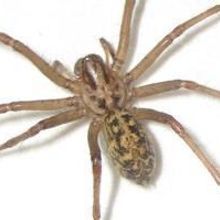Login
Subscribeinsects, evolution

Some Bats Buzz Like Hornets to Deter Predators
Natalia Mesa, PhD | May 9, 2022 | 2 min read
The behavior is the first example of a mammal mimicking a more-dangerous species.

Why Are Some Beetles Shiny? It’s Not What Researchers Thought
Connor Lynch | Mar 1, 2022 | 4 min read
The glossy shell of some beetles, it has long been speculated, helps hide the insects from predators. A recent paper put the hypothesis to the test—and found it wanting.

Generations of Insect Attacks Drive Plants to “Talk” Publicly
Ashley Yeager | Mar 1, 2020 | 4 min read
Goldenrods that evolved in the presence of herbivores release volatile chemicals that trigger defenses in neighboring plants of their species, even those that are genetically unrelated.

Image of the Day: Water Flea
Sukanya Charuchandra | May 29, 2018 | 1 min read
A species of water flea in northern Belgium that helps keep algae in check is growing smaller and less abundant in urbanized areas.

Image of the Day: Ectopic Wings
The Scientist and The Scientist Staff | Jan 24, 2018 | 1 min read
Insect wings may have evolved from multiple origins, say researchers.

Image of the Day: Minions of the Cicada
The Scientist and The Scientist Staff | Jan 9, 2018 | 1 min read
Scientists study the unusual genome evolution of the bacteria that live within a genus of cicadas.

Image of the Day: Moth Resurrection
The Scientist and The Scientist Staff | Dec 18, 2017 | 1 min read
Entomologists have rediscovered a species of moth that was considered lost for 130 years.

These Flies Hijack Frogs’ Love Calls
Mary Bates | Nov 1, 2017 | 5 min read
The phenomenon is one of the few examples of eavesdropping across the vertebrate/invertebrate barrier.

Gene Behind Black Peppered Moth’s Color Change Identified
Tanya Lewis | Jun 6, 2016 | 2 min read
A transposon underlies this classic story of evolutionary adaptation.

Spider and Centipede Venom Remarkably Similar
Bob Grant | Jun 12, 2015 | 2 min read
The predatory toxins employed by animals separated by millions of years of evolution are virtually identical, a study shows.

A Deathly Pallor
Carina Storrs | Mar 1, 2015 | 4 min read
Global warming could lead to lighter-colored insects with waning immune defenses.

Genetic Data Clarify Insect Evolution
Kate Yandell | Nov 6, 2014 | 3 min read
Researchers create a phylogenetic tree of insects by comparing the sequences of 1,478 protein-coding genes among species.

Sleep Tight
Emily Monosson | Oct 1, 2014 | 3 min read
Bed bugs are but one example of a species whose populations have evolved in response to human behavior.

Book Excerpt from Unnatural Selection
Emily Monosson | Sep 30, 2014 | 4 min read
In chapter 5, “Resurgence: Bedbugs Bite Back,” author Emily Monosson chronicles the rise of the pesky pests in the face of humanity’s best chemical efforts.

Week in Review: June 16–20
Tracy Vence | Jun 20, 2014 | 2 min read
Early Neanderthal evolution; developing antivirals to combat polio; the mouth and skin microbiomes; insect-inspired, flight-stabilizing sensors

The Shared Perfumes of Queens
Ed Yong | Jan 16, 2014 | 3 min read
Ant, bee, and wasp queens emit a similar class of pheromones that sterilize their workers, hinting at a shared ancestry for these chemicals.

Fossilized Mosquito Blood Meal
Abby Olena, PhD | Oct 14, 2013 | 3 min read
Researchers have discovered a 46-million-year-old female mosquito containing the remnants of the insect’s final blood meal.

Photonic Colored Creatures
Cristina Luiggi | Jan 31, 2013 | 1 min read
Animals and plants come in a dizzying array of colors. Current research is cracking into the remarkable structures behind nature's artistic display.
Home Cookin’
Hayley Dunning | Oct 1, 2012 | 4 min read
Laboratory-raised populations of dung beetles reveal a mother's extragenetic influence on the physiques of her sons.
